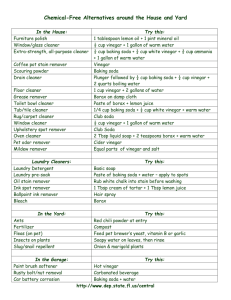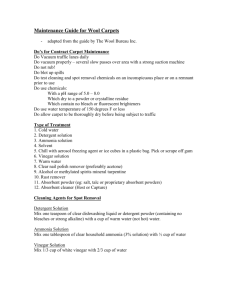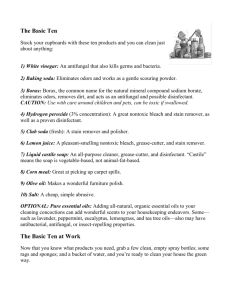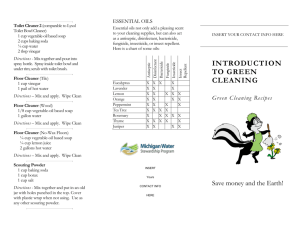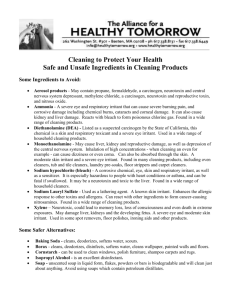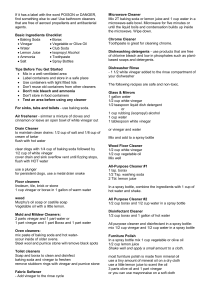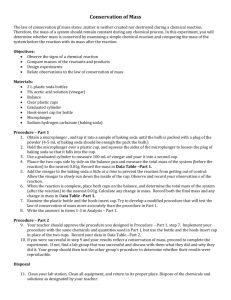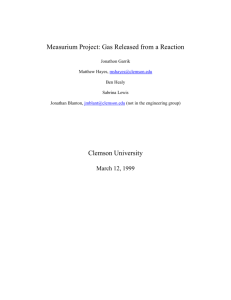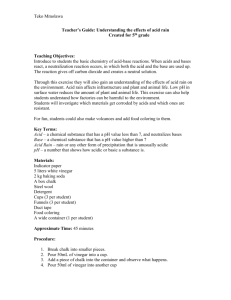using and making a cleaner
advertisement
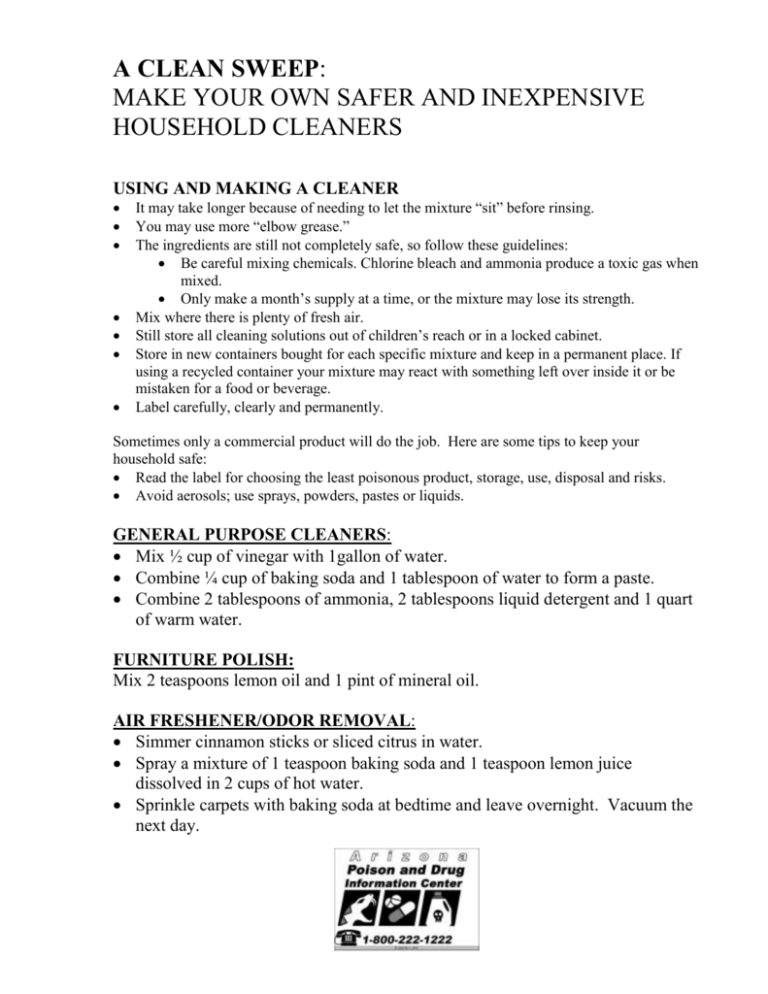
A CLEAN SWEEP: MAKE YOUR OWN SAFER AND INEXPENSIVE HOUSEHOLD CLEANERS USING AND MAKING A CLEANER It may take longer because of needing to let the mixture “sit” before rinsing. You may use more “elbow grease.” The ingredients are still not completely safe, so follow these guidelines: Be careful mixing chemicals. Chlorine bleach and ammonia produce a toxic gas when mixed. Only make a month’s supply at a time, or the mixture may lose its strength. Mix where there is plenty of fresh air. Still store all cleaning solutions out of children’s reach or in a locked cabinet. Store in new containers bought for each specific mixture and keep in a permanent place. If using a recycled container your mixture may react with something left over inside it or be mistaken for a food or beverage. Label carefully, clearly and permanently. Sometimes only a commercial product will do the job. Here are some tips to keep your household safe: Read the label for choosing the least poisonous product, storage, use, disposal and risks. Avoid aerosols; use sprays, powders, pastes or liquids. GENERAL PURPOSE CLEANERS: Mix ½ cup of vinegar with 1gallon of water. Combine ¼ cup of baking soda and 1 tablespoon of water to form a paste. Combine 2 tablespoons of ammonia, 2 tablespoons liquid detergent and 1 quart of warm water. FURNITURE POLISH: Mix 2 teaspoons lemon oil and 1 pint of mineral oil. AIR FRESHENER/ODOR REMOVAL: Simmer cinnamon sticks or sliced citrus in water. Spray a mixture of 1 teaspoon baking soda and 1 teaspoon lemon juice dissolved in 2 cups of hot water. Sprinkle carpets with baking soda at bedtime and leave overnight. Vacuum the next day. BATHROOM CLEANER: ½ cup bleach and 1 cup of water, wiped on and left for 5 minutes will remove mildew from tile. Vinegar and water removes mildew from shower curtains and water spots from faucets. Borax and lemon juice cleans and deodorizes the toilet. ¼ cup of cornstarch, ½ cup ammonia and 1 cup vinegar on windows or shower doors for removing rust and lime deposits. DRAINS: For a weekly drain cleaner mix 2 tablespoons of baking soda, ½ cup vinegar with 1 quart of warm water and pour down the drain. Let sit ½ hour and rinse with 3 quarts of hot water. To unclog drain: Mix 1 cup of baking soda, one cup salt, and 1 cup of white vinegar. Expect fizzing while it sits for 15 minutes. Then pour it down the drain and follow with a few cups of boiling water. KITCHEN: Baking soda makes a good scouring powder for counters, fine china, coffeepots, and toasters. Vinegar in the rinse water removes spots on glassware. Oven cleaner: Sprinkle baking soda on stains. 5 minutes later scrub with a damp cloth. WINDOW CLEANER: (Note - remove chemical cleaner with ammonia first, or you may get streaks when using vinegar solutions.) ½ cup of vinegar in 1 gallon of water, wiping off with newspaper. ¼ cup of ammonia in 1 gallon of water, wiping off with newspaper, again. FLOOR CLEANER: Mix 1 cup vinegar OR ½ cup of ammonia in a bucket of water. If there is a wax or dirt buildup, use 2 cups of ammonia per gallon of water and let sit for 20 minutes before rinsing off. Dissolve 1/2cup of borax in 2 gallons of hot water. HOUSEHOLD HAZARDS CLASS PESTICIDES INSIDE OUTSIDE KIDS STATISTICS GENRAL PREVENTION DOSING/CHILD DEVELOPMENT APDIC SERVICES PREVENTION AND FIRST AID 4 ROUTES MEDICATIONS KIDS ADULTS SENIORS PETS HOUSEHOLD HAZARDS CLEANERS AND SAFER ALTERNATIVES LABELS: CLASSIFICATION, PREVENTION TOILETRIES AND COSMETICS
